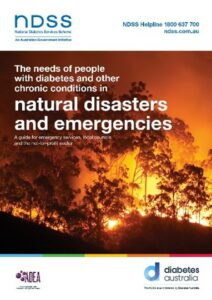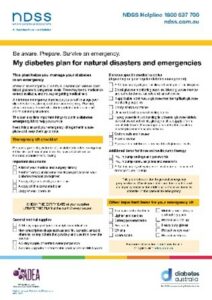Managing diabetes during and after disasters – updated resources

Introduction
No matter where someone lives in Australia, severe weather events and natural disasters can happen anytime—especially in summer. Whether it’s a bushfire zone or a cyclone region, it’s important for people living with diabetes to have a diabetes emergency plan and kit so they can:
- self-manage their diabetes in the event of an emergency
- reduce the impact of the emergency on managing their diabetes
- recover more quickly after an emergency.
Health professionals play a vital role in providing education and ensuring people living with diabetes are prepared in the event of a natural disaster or emergency.
Background
In 2013, ADEA conducted a review of internationally available disaster management guidelines and best practice for the National Diabetes Services Scheme (NDSS) along with a consultation with Australian diabetes organisations. As a result of this, a project to develop resources to support people living with diabetes in the event of a natural disaster or emergency was implemented between 2013-2015. The outcome of this project was the development of resources to address the needs of people with diabetes, health professionals and emergency services. The aim of these resources was to provide information on managing diabetes and other chronic diseases during and after a natural disaster or emergency.
The NDSS suite of resources included a flyer, poster and an emergency plan that covers important information to help manage diabetes during a natural disaster or emergency.
A handbook titled ‘The needs of people with diabetes and other chronic conditions in natural disasters – A guide for local councils, emergency services and the not-for-profit sector’ was also developed. In addition to this, online learning modules for health professionals were developed to provide continuing professional development on how natural disasters and emergencies effect people living with diabetes and how they can prepare for a natural disaster or emergency.
Review and update of NDSS natural disaster management resources
In 2020 a review of the disaster management resources was conducted and the results were used to update the resources. The review was multifaceted and included feedback from the original expert reference group, responses to a broad call for submissions from emergency service providers, disaster relief providers and local councils, and feedback received from the online learning modules evaluation survey. The update of the resources included:
- minor content/language edits and design changes
- updating of links and references
- identification of any major changes required
- updating links on NDSS website and ADEA website.
The updated suite of resources includes:
A handbook for organisations and personnel who deal with natural disasters and emergencies during the planning stages such as local disaster management groups (local council) as well as those who deal with ‘on-the-ground’ situations after a natural disaster has occurred, for instance, those managing evacuation centres.

A plan for people with diabetes, providing information on how to manage diabetes during a natural disaster or emergency, lists medical details and essential contacts and has a checklist for preparing a diabetes emergency kit. This plan is also available in Arabic, Chinese simplified, Chinese traditional, Vietnamese and Turkish.

A flyer explaining how to use the natural disaster and emergency plan to help manage diabetes in an emergency.
A poster which can be used to promote the natural disaster and emergency resources.
All the updated NDSS disaster management resources are available at ndss.com.au/emergencies-and-diabetes.
You can access the updated online learning modules here.
Conclusion
ADEA welcomes any feedback on the updated disaster management resources, contact ndss@adea.com.au
Acknowledgements
This project was funded through the National Diabetes Services Scheme (NDSS). The NDSS is an Australian Government initiative administered by Diabetes Australia. ADEA is a National Health Professional Body Agent for the NDSS.